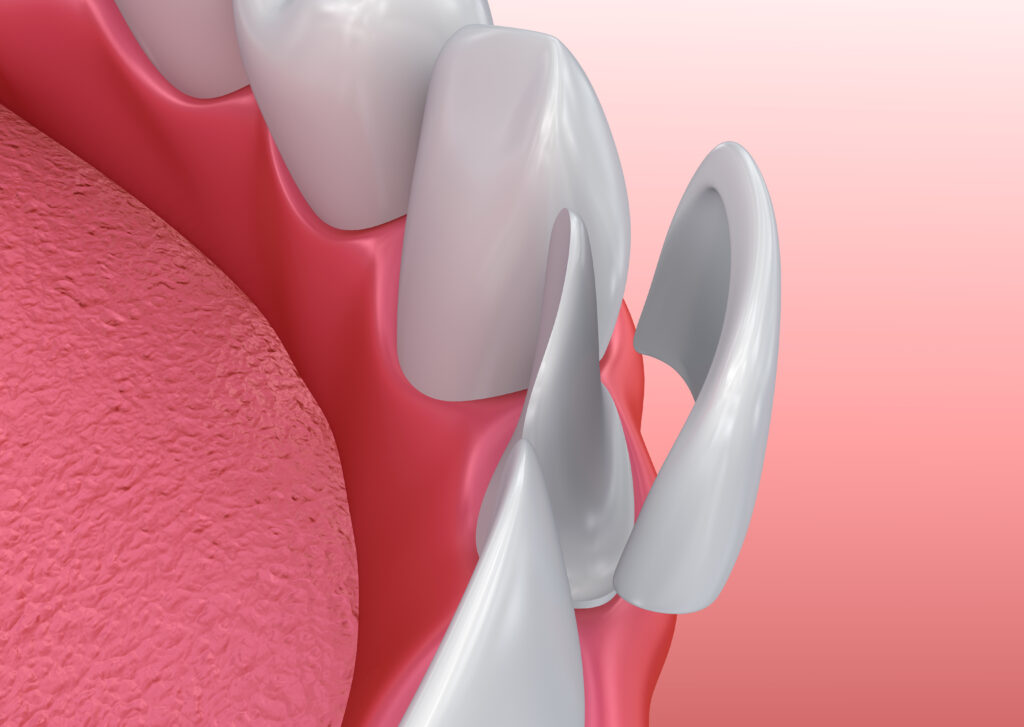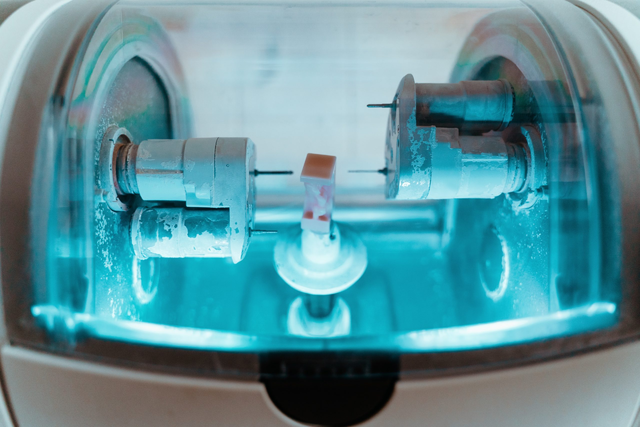If small to moderate imperfections in your smile are bringing you down, dental veneers are a simple solution. Veneers are thin porcelain coverings that are placed over the front part of your tooth, restoring your smile with simplicity and durability.
Give yourself a seamless new smile through dental veneers. Call Bridge Creek Dental in Billings, MT, to learn more about how our premium dental tools can help you.

The Benefit of Dental Veneers
Veneers can be used to correct a wide range of cosmetic dental issues, such as:
- Tooth Gaps: These tools can even help conceal uneven spaces between teeth. Veneers can be a great long-term cosmetic option to address these concerns.
- Stained Teeth: Dental veneers can be a great alternative when typical teeth whitening procedures aren’t able to clear certain stains from your smile.
- Chipped/Damaged Teeth: Tooth accidents and decay can lead to worn teeth that make it difficult to chew and articulate properly. Dental veneers can clear these complications.
- Crooked Teeth: Don’t let crooked teeth stand in the way of feeling committed to your smile. Dental veneers can address minor orthodontic issues in a single visit.
Make a Difference in Your Health
Dental veneers are so much more than a cosmetic touch-up. With the help of the Bridge Creek Dental team, these modern dental tools can provide these long-term health benefits:
Care Focused on You
Bridge Creek Dental is committed to providing a high-class experience for our patients that provides lasting, substantial results. In the scope of dental veneers, here’s how we make these results happen:
Advanced Dental Experience
Dr. Taylor and the rest of the Bridge Creek Dental Team come equipped with post-graduate education in advanced dental techniques, such as veneers. Our office has two different in-house dentists as well, providing an extra layer of expertise and flexibility to your dental treatment.

Emergency Dental Care
Some cases may call for dental veneers on short notice. We suggest having our dental team on hand for when these situations may arise. We are happy to offer after-hours appointments for patients on record in these cases.
Call our office as soon as the emergency happens to receive immediate attention. We are happy to help!
Sedation Dentistry
Clear the intimidation, anxiety, and gag reflex that sometimes comes with dentistry using dental sedatives. These tools put the patient at a state of ease while the dental procedure takes place, providing a serene and comfortable experience.
In addition to this, dental sedation allows our team to perform each high-end procedure efficiently and with ease. This opportunity decreases time spent in the dentist’s chair and helps each patient receive exceptional results and experiences while visiting our clinic.
About Our E.Max Press for Veneers
Here at Bridge Creek Dental, we use the most up-to-date practices and technology in our dental treatments. One of the advanced tools we provide is the e.max Press for our dental veneer treatments. These are some of the few perks of e.max veneers compared to traditional options.
- Flexible Materials: E.max is a Lithium Disilicate class (all-ceramix) system. We will use this ceramic material to create your custom veneers in-office.
- Ideal Color Matching: This ceramic system has multiple color and translucency options, allowing it to be aesthetically pleasing and fit in with your current smile.
- Quick Recovery Time: Because we create these veneers in-office, the treatment time will be kept short, allowing you to get your new smile quicker.
- Long-Lasting: E.max dental veneers last longer than conventional veneers, providing your new smile with an extra layer of protection from chipping and damage.
Learn more about dental veneers by scheduling your first consultation with us! Give us a call today!

Placing Dental Veneers
We are dedicated to helping our patients understand and feel comfortable in their dental treatments. We’ve listed below the steps we follow to give you the best veneers possible. If you have any questions regarding the veneer service, feel free to ask us during the first visit.

Veneer Aftercare
It’s essential to take proper care of your veneers to keep them looking and functioning at their best. Luckily enough, dental veneers require the same maintenance as a natural smile. We’ve listed a few great pointers to help you with aftercare for your new veneers:
- Watch What You Eat: Avoid colored drinks such as coffee, tea, or red wine to limit stains on your dental veneers. Just like your regular smile, a healthy diet can go a long way to reduce gum infections and tooth decay.
- Create a Dental Schedule: Be sure to visit the dentist regularly for professional cleanings and exams. While you’re at home, stick to healthy oral hygiene habits such as brushing and flossing at least twice a day.
- Be Careful How You Chew: Unnecessary tooth strain can make a big impact on your veneers. Nail biting, bruxism, or chewing overly hard foods weaken your teeth’s foundation and lead to urgent dental matters.
Protect Your Smile: Hard-contact sports such as football or wrestling can quickly lead to a dental appointment from dental trauma. Reduce the risk of blunt trauma by using mouthguards to protect your smile while participating in these events.
Don’t Hold Back from Dental Veneers
We wholeheartedly understand the need to understand the full context of the procedure before taking the first step. To make this transition as seamless as possible, we’ve listed some common concerns in a low-pressure environment.
Feel free to give our office a call if you have any other concerns regarding this dental treatment. We are happy to walk you through your options to help you feel at ease about starting treatment.
Do Dental Veneers Hurt?
Dental veneers do not hurt while the procedure takes place, thanks to the help of anaesthesia and other sedation dentistry options. You might feel some slight pain once the sedatives have worn off, but the pain should subside within a few days.
The exciting part about this procedure is that you can swap chronic discomfort from problematic teeth for temporary pain as the tooth adjusts. While you’re in this moment, here are a few tips to minimize pain symptoms:
- Use Pain Medication: Pain medication such as Advil can temporarily relieve symptoms and reduce the amount of time you are currently in pain.
- Swish Salt Water: Swishing a small amount of salt water can temporarily relieve swelling and other symptoms that are causing dental pain.
- Eat Soft Foods: Try to stick to the diet Drs. Wassmer and Taylor recommend to relieve unnecessary pain. Some great soft foods include yogurt and smoothies.
Adjusting to Dental Veneers
Once the temporary pain has subsided, there are no urgent complications that come with dental veneers. Dental veneers might influence your speech for a short time as well, but patients get used to the tools once they’ve practiced articulating enough.
To further support you through this transition, we might schedule follow-up visits to see how you respond to the dental veneers.
How Long Do Dental Veneers Last?
E.max dental veneers can last over 15 years with proper care and maintenance. These tools rely on your efforts for long-lasting results, so be sure to schedule dental visits biannually and keep up with personal dental habits to see long-lasting results.
Options Outside of Veneers
Depending on the scope of your dental damage and medical history, we might suggest alternative options to help you receive the far-reaching effects you need from treatment. We’ve listed below a few options we offer and the circumstances that might warrant them.
- Teeth Whitening: Teeth whitening is typically the first route we take to fight back against tooth stains due to its cost-effective and straightforward nature for our patients.
- Dental Crowns: Dental crowns are utilized in cases where we are unable to use the surrounding tooth structure to fix your tooth.
- Tooth Bonding: Tooth bonding is another alternative to help fix more minor tooth cracks and smudges that are in the way of an aesthetically pleasing smile.
Do Dental Veneers Replace Missing Teeth?
Dental veneers rely on the natural tooth structure for foundational support. Without that support, the dental veneer is unable to fasten itself onto your smile. If you happen to deal with missing teeth, dental crowns and other restorative treatments would be a better option for your needs.
Feel free to visit our Restorative Dentistry page for more information about these services.
Transform Your Smile Today!
Veneers might be a great option to transform your smile! Give our office a call to schedule your first consultation with one of our highly-trained dentists.